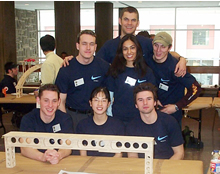|

BY MARY GRACE DE GUZMAN
University of Calgary
The Confederation Bridge. The Golden Gate Bridge. The London
Bridge. Not only are these bridges among the most famous in
the world, but also at one point each of them must have started
out as models. And that is exactly what civil engineering
students at the University of Calgary set out to do: create
a model of a bridge.
But out of what material? The bridge must sustain hundreds
and sometimes even thousands of kilograms of weight. So, perhaps
the mostly likely and obvious choice would be 1060 mild steel.
but such was not the case. The bridge must be less than four
kilograms and as the rules from the Concordia Bridge Building
Competition state, must be made simply of glue, dental floss
and Popsicle sticks!
The legendary 18th annual Concordia Popsicle Bridge Building
Competition was held on March 8.
The first competition was in 1984, then just a small contest
within the departments of building between civil and environmental
engineering students. That marked the first annual Concordia
Bridge Building competition, held at Concordia University
in Montreal.
The tradition continued and eventually expanded internationally,
in 1991. This year, a total number of 40 teams, a total of
208 students, participated. This included five U.S. teams
and one European team, from Fance.
The University of Calgary was the only Western university
that participated in the competition, sending two teams to
Montreal: The Little Bridge That Could team (Stan Wojciezczyk
, Shamshir Jessa, Ryan Bakay, Marcus Laberda and Steven Kay)
and the A-team (Charmaine Yu, Ken Lee, Japji Chahal, Denis
Dejsus, Blair Schoefield, Conrad Binkmier, and Lorain Ruess).
Withstands 30 Kilograms
The bridges were judged based on three specific criteria:
10 per cent creativity, 25 per cent esthetics, and 65 per
cent resistance factor. The Little Bridge That Could placed
15th as their bridge was able to withstand a 30-kilogram load
and the A-team placed seventh, sustaining 800 kg. In addition,
the A-Team was also awarded second place in the most innovative
design, utilizing dental floss as a tension member. You'd
be amazed to know that the University of Calgary holds the
competition record of amount of sustained load for a bridge
-- weighing less that 4 kg, but withstanding 5,030kg!
This was a tremendous learning opportunity for all the students
involved. Mr. Wojciezczyk, for The Little Bridge That Could
team, says this about the competition: "This year, all
the students pushed the boundaries of innovation to try things
that had never been done before. We wanted to send two bridges
to the competition that were technically unique. We found
the strengths and weaknesses in our design which will propel
continuous improvement over the next coming years."
Congratulations to both teams for a job well done and a special
thank you to all the sponsors.
|



